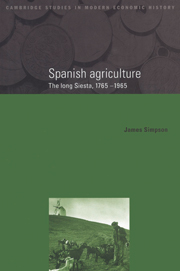Book contents
- Frontmatter
- Contents
- List of illustrations
- List of tables
- Acknowledgements
- Note on the regional division of Spain
- Abbreviations and conventions
- Introduction
- Part I The relative backwardness of Spanish agriculture
- Part II Traditional technologies and market opportunities, 1765–1880
- Part III The limits to technical change, 1880–1936
- Part IV Markets and institutions, 1880–1936
- Part V The State and the end of traditional agriculture
- 11 The modernisation of Spanish Agriculture, 1939–1965
- Conclusion
- Appendix Estimates of agricultural output and consumption in nineteenth-century Spain
- Bibliography
- Index
11 - The modernisation of Spanish Agriculture, 1939–1965
Published online by Cambridge University Press: 04 December 2009
- Frontmatter
- Contents
- List of illustrations
- List of tables
- Acknowledgements
- Note on the regional division of Spain
- Abbreviations and conventions
- Introduction
- Part I The relative backwardness of Spanish agriculture
- Part II Traditional technologies and market opportunities, 1765–1880
- Part III The limits to technical change, 1880–1936
- Part IV Markets and institutions, 1880–1936
- Part V The State and the end of traditional agriculture
- 11 The modernisation of Spanish Agriculture, 1939–1965
- Conclusion
- Appendix Estimates of agricultural output and consumption in nineteenth-century Spain
- Bibliography
- Index
Summary
The slow changes in Spanish agriculture during the first third of the twentieth century ground to a halt in the early 1930s. For the next two decades agriculture, together with the rest of the economy, declined and then stagnated. In this chapter, I argue that this long decline in agricultural output cannot be fully explained by either the 1936–9 Civil War or government intervention in commodity markets, which distorted incentives, farm incomes and consumption. Instead, other factors, such as Spain's international isolation and the decline in foreign trade, which in turn restricted the imports of fertilisers and machinery, provide the best explanation of why recovery took longer than in most other European countries. Only from the early 1950s was growth renewed, and by 1960 agricultural modernisation was once more clearly taking place.
This chapter also considers how three major bottlenecks to agricultural growth in the pre-Civil War period were finally overcome. First, the process of outmigration was renewed from the early 1950s, leading to a rapid rise in rural wages, with the domestic terms of trade moving against wheat farmers. For the medium and large wheat farmer this did not imply falling incomes, as mechanisation allowed costs to be cut. Only by the late 1960s would improved seed technologies and cultivation methods raise yields.
- Type
- Chapter
- Information
- Spanish AgricultureThe Long Siesta, 1765–1965, pp. 243 - 262Publisher: Cambridge University PressPrint publication year: 1996



